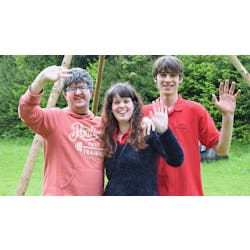Babies are born with the innate need and desire to suck. Aside from learning to latch on while breastfeeding, babies will suck whatever is placed into their mouths. Nonnutritive sucking (NNS)—when a baby sucks on a pacifier or digit, whether thumb or otherwise—is a common behavior for babies to self-soothe, fight boredom, and ease to sleep. These nonnutritive habits, however, have been shown to contribute to malocclusion and other orofacial abnormalities. Some of the most common results seen from these nonnutritive habits include anterior open bite (AOB), anterior overjet (AO), posterior crossbite (PCB), and oral myofunctional disorders (OMD).
Nutritive vs nonnutritive sucking
There are two types of sucking for babies—nutritive sucking, such as breastfeeding or bottle feeding, which provides nutrition; and nonnutritive sucking, such as on a digit or pacifier.
Breastfeeding is suggested by the World Health Organization (WHO) immediately following birth for at least the first six months of life. This establishes a strong bond with the mother, develops musculature properly, and provides needed nutrition for the earliest stages of life.2 WHO recommends dissuading pacifier use as it may hinder the baby’s ability, longevity, or likelihood to breastfeed. This, however, may contribute to an increase in thumb or digit sucking.
The American Academy of Pediatric Dentistry (AAPD) says the length of time children spend using pacifiers or sucking on digits will determine how the orofacial structures are affected during development. This may lead to children possibly needing appliances to help in the cessation of either of these NNS habits if it extends past the age of three.5 Anterior open bite, anterior overjet, posterior crossbite, and orofacial myofunctional disorders are all risks of NNS. The effects of these NNS habits are determined by their duration and frequency.8
Many studies have been done regarding the type of feeding, whether breastfed or bottle fed, and the effects on orofacial structures. There have been no significant findings of altered occlusion as a direct result of feeding method.10 This may come as a relief to many parents as there can sometimes be extraneous reasons as to why a mother cannot breastfeed. What has been shown to be directly correlated in altering the occlusion of the deciduous dentition is NNS.
Types of pacifiers
There are different types of pacifiers—conventional, orthodontic, and thin-neck—that have been studied for their effects on the deciduous dentition. Conventional pacifiers have been around the longest. According to Schmid et al., this type of pacifier has been found to diminish the likelihood of proper development of the orofacial structures and discourages longevity of breastfeeding. Orthodontic pacifiers were developed later on, making claims to reduce the incidence of malocclusion, but studies do not support these findings.8,11 Since pacifiers are used from birth, when no teeth are present, “they may hinder the full eruption of the primary incisors as well as the growth of the alveolar process, resulting in an anterior open bite.”7
A thin-neck pacifier (TNP), however, has been shown to reduce malocclusion when compared to other types of pacifiers.11 A study by Wagner and Heinrich‐Weltzien found that spontaneous correction occurred in numerous children when they switched from a conventional pacifier to a TNP. This study agreed with the AAPD that properly weaning the child off of a pacifier by age three gives the child the best opportunity to properly develop the dento- and maxillofacial structures.11
According to a study by Larsson and Bishara, “Artificial sucking habits, however varied, are common in the industrialized world of today, the main reason being that breastfeeding is reduced both in intensity and in duration. Crossbite and tendencies to crossbite should be carefully checked in two- to three-year-olds with artificial sucking habits. However, greater harm to the dentition is caused by digit sucking, both because the thumb acts as a lever, forcing the maxilla forward, and because the habit is harder to stop.”7
Due to its availability, digit sucking is harder to break than habits with pacifiers. Many times, parents revert back to a pacifier to stop the child from sucking his or her digits.8 This may lead the child into a potentially longer lasting relationship with the NNS habit, thereby increasing the likelihood for AOB and AO as a “result of the labial inclination of the upper incisors.”7
Posterior crossbite can be brought on by improper use of orofacial muscles, causing the palate to develop oddly.10 Not many studies blame pacifier use alone, however. The main culprit to PCB is pacifier use combined with digit sucking, or continual use of a pacifier, both day and night.8 Posterior crossbite is defined as a “reverse transverse interrelation of one or several teeth (canine and/or deciduous molars) on either or both hemi-arcades.”10 Viggiano et al. also found that babies who were breastfed were at less risk of PCB.10
Proper use, positioning, and function of the tongue also plays a huge part in the developing deciduous dentition.4 NNS habits can inhibit the tongue’s proper resting place, creating orofacial myofunctional disorders (OMD).12 These disorders “impact treatments by orthodontists, dentists, dental hygienists, speech-language pathologists, and other professionals working in the orofacial area.”12 The Academy of Orofacial Myofunctional Therapy addresses the numerous dental problems related to poor tongue function. When sucking on a digit, the tongue is forced “into a low position that pushes it against the teeth,”12 which contributes to AOB, AO, and PCB as a result of improper oral posture and positioning of the muscles of the face.12
Corrective measures
There are many corrective measures that can be taken to rectify these conditions and malocclusions to prevent the need for invasive orthognathic surgery if treatment begins before loss of all primary teeth.1 These malocclusions (PCB, AOB, and AO) have been seen to spontaneously correct themselves in some instances;6,8 however, early intervention and correction using selective occlusal equilibration and/or orthodontic appliances have been shown to be necessary to achieve centric occlusion and proper myofunction.6,9 “Jaw surgery can have a dramatic effect on many aspects of life”;3 therefore, taking a preventative approach while children are still in the first two to three years of life to cease these NNS habits will greatly decrease the chance of required orthognathic surgery due to the immaturity of the developing dento- and maxillofacial structures.6
Conclusion
Babies are born with the need and desire to suck. If their needs are not being met with their method of feeding, they will seek comfort in a nonnutritive manner, whether with a digit or a pacifier. Studies have shown there is a negative effect on the development of the dento- and maxillofacial structures when a child has any of the discussed nonnutritive sucking habits. It is therefore recommended that children are limited in the duration and frequency of any nonnutritive sucking habit that contributes to anterior open bite, anterior overjet, posterior crossbite, and orofacial myofunctional disorders. Children should also be encouraged to breastfeed for at least the first six months if possible. If it is necessary for the baby or parents to introduce a pacifier, studies have proven there are fewer effects on the formation of the maxillofacial structures if a thin-neck pacifier is used. Although spontaneous correction of open bite, overjet, and rarely posterior crossbite have been seen in follow-up studies, prevention is easier than potential treatment involving invasive orthognathic surgery, extensive orthodontics, or even lifelong malocclusion. Further research will help to determine modalities to prevent and treat complications that arise from NNS habits.
References
1. de Almeida MR, de Almeida RR, de Castro Ferreira Conti AC, et al. Long-term stability of an anterior open-bite malocclusion treated in the mixed dentition: a case report. J Appl Oral Sci. 2006 Dec;14(6):470-475. https://www.ncbi.nlm.nih.gov/pmc/articles/PMC4327302/. Accessed September 10, 2018.
2. World Health Organization. Breastfeeding. August 06, 2018. http://www.who.int/topics/breastfeeding/en/. Accessed September 8, 2018.
3. American Association of Oral and Maxillofacial Surgeons. Corrective jaw surgery. https://myoms.org/procedures/corrective-jaw-surgery. Accessed September 10, 2018.
4. Darby ML, Walsh MM. Dental Hygiene: Theory and Practice. St. Louis, MO: Saunders Elsevier; 2010.
5. American Academy of Pediatric Dentistry. Frequently Asked Questions. http://www.aapd.org/resources/frequently_asked_questions/#316. Accessed September 9, 2018.
6. Kurol J, Berglund L. Longitudinal study and cost-benefit analysis of the effect of early treatment of posterior cross-bites in the primary dentition. Eur J Orthod. 1992 Jun;14(3):173-179. doi:10.1093/ejo/14.3.173
7. Larsson E, Bishara S. Pacifier- and digit-sucking habits. Can J Dent Hyg. 2007 Jan-Feb;41(1):23-29.
8. Schmid KM, Kugler R, Nalabothu P, Bosch C, Verna C. The effect of pacifier sucking on orofacial structures: A systematic literature review. Prog Orthod. 2018 Mar 13;19(1):8. doi:10.1186/s40510-018-0206-4
9. Thilander B, Wahlund S, Lennartsson B. The effect of early interceptive treatment in children with posterior cross-bite. Eur J Orthod. 1984 Jan;6(1):25-34. doi:10.1093/ejo/6.1.25
10. Viggiano D, Fasano D, Monaco G, Strohmenger L. Breast feeding, bottle feeding, and non-nutritive sucking; effects on occlusion in deciduous dentition. Arch Dis Child. 2004 89(12):1121-1123. doi:10.1136/adc.2003.029728
11. Wagner Y, Heinrich‐Weltzien R. Effect of a thin‐neck pacifier on primary dentition: A randomized controlled trial. Orthod Craniofac Res. 2016Aug;19(3):127-136. doi:10.1111/ocr.12126
12. Academy of Orofacial Myofunctional Therapy. What is myofunctional therapy? https://aomtinfo.org/myofunctional-therapy. Accessed September 29, 2018.
Mindi L. Lindahl, RDH, has six-plus years of clinical dental hygiene experience and currently practices in Larkspur, Colorado. She is currently pursuing a degree completion program emphasizing public health. She constantly seeks to expand her knowledge in dental hygiene to better serve not only her patients but also her community. Mindi can be reached at [email protected].







